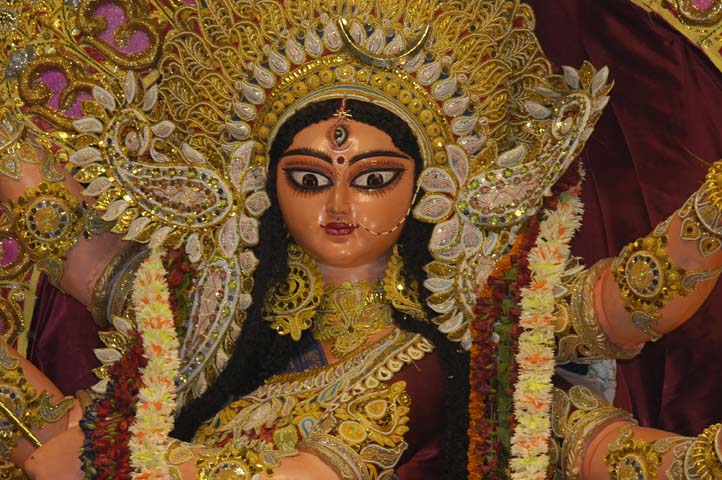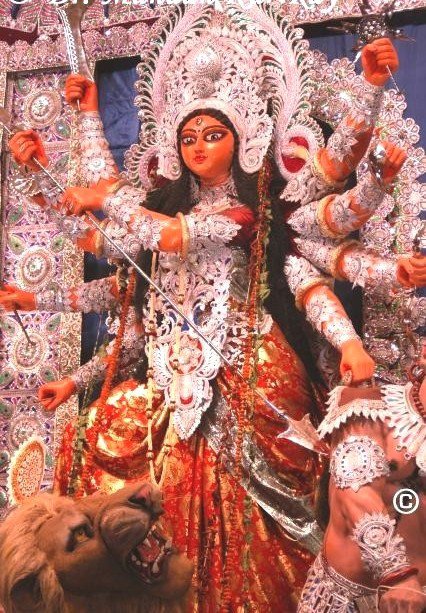By Smita Mukerji

The triumvirate design of Reality as an endless cycle of creation, sustenance and destruction is commonly well-understood in India. To the Indian mind nothing is out of the realm of Supreme Nature, nothing either good or evil. Every aspect of Nature is acknowledged in Hindu iconography, illustrated in its mythology and sanctified in its virtually infinite number of traditions of worship. The aspirant chooses his/her ideal according to the innate disposition or bhāva.
Durgā is also known as ‘Rudrānī’ the fearsome aspect of Pārvatī. She is referred to as Ghōrā (the fierce one), Ugrā (wrathful) and Raudra-rūpā (manifestation of Rudra’s fury). She is the sanguine War Goddess infused with symbols of vigour, potency and ferocity which evokes manliness to righteous action. Yet, She is a form of the same Mother who creates, nurtures and delivers with Her boundless love, in whom every one of Her creatures may seek refuge. The pratimā (clay idol) of Durgā is meant to convey this imagery as being the most powerful positive motive force in Nature.
Through the ages, man has observed the gentle and nurturing Mother Nature around him that could transform into a terrifying, destructive power, and attempted to understand it by creating paradigms of good and evil. Durgā is the anthropomorphic representation of this entirety of Nature.
As a mother tigress who gently licks and suckles her cubs turns into the ferociously protective mother if they were to ever be threatened, Nature was visualised as protecting the good and destroying evil. But as the tigress catches the cubs by the scruff in her teeth to move them from one place to another, the cubs give in completely to her terrifying jaws that can tear apart an animal trusting her motherly nature. Similarly, to That loving and motherly form of the Divine do we trust and surrender when faced with causes beyond our comprehension and control, like death and destruction.
As per the Durgā Saptaśatī of Mārkaṇdēya Purāña (commonly referred to as the ‘Ćaṇdī’), after an interminably long battle had raged between Durgā and the asuras (dark forces) the Mother was unable to slay the king of the asuras, the demon Mahīṣāsura. Being pure sat (the purest energy of harmony and constructiveness) She could not in that state effect the destruction of any being, Her own creation. So She consumed madya (liquor) to assume ‘tamōguña’ (in the present sense, negative quality) in order to transform into the energy of destruction.
In the narration in Dēvī Bhāgavatam, “Vyāsa said–O King! Saying thus, the Dēvī, wrathful and eager to kill Mahīṣāsura, took up the golden cup filled with wine and drank again and again…” (5.18.54-70)
The Durgā Saptaśatī narrates the moments before the Dēvī slew Mahīṣāsura thus:
 ततः क्रुद्धा जगन्माता चण्डिका पानमुत्तमम् ।
ततः क्रुद्धा जगन्माता चण्डिका पानमुत्तमम् ।
पापौ पुनः पुनश्चैव जहासारुणलोचना ॥३.३४॥
ननर्द चासुरः सोऽपि बलवीर्यमदोद्धतः ।
विषाणाभ्यां च चिक्षेप चण्डिकां प्रति भूधरान् ॥३.३५॥
सा च तान् प्रहितांस्तेन चूर्णयन्ती शरोत्करैः ।
उवाच तं मदोद्धूतमुखरागाकुलाक्षरम् ॥३.३६॥
देव्युवाच ॥३७॥
गर्ज गर्ज क्षणं मूढ मधु यावत्पिबाम्यहम् ।
मया त्वयि हतेऽत्रैव गर्जिष्यन्त्याशु देवताः ॥३.३८॥
“[As Mahīṣāsura took anew the form of a terrible buffalo and threatened the creatures of the three worlds] …the enraged ‘Jagaṅmāta’ (Mother of the Universe) consumed madya (intoxicating drink) again and again and with bloodshot eyes burst out in terrifying laughter.
At this, the demon roared drunk with his own power and glory, and moving mountains with his horns hurled them at the Dēvī.
Casting asunder the mountains thrown at Her with a shower of arrows, the Dēvī spoke. And as She spoke Her speech was slurred and Her face aflame with the effect of madya…
Said the Dēvī:
Exult but for a few more moments, O fool, until I drink this wine. When I have slayed thee with My hands will the Dēvas soon rejoice at thy end.”

To bring out this awe-inspiring expression of the Goddess takes the skill of a master craftsman in Kumartuli, the locality in Kolkata where the community of sculptors live, who have since ages crafted pratimās for worship. Few of these master-craftsmen possess that proficiency now, as a result of which most Durgā images have acquired a uniform benign expression, which however does not convey the bhāva (essence) of the narration in the ‘Ćaṇdī’ nor the specific aspect of Dēvī being worshipped in Durgā, the One blazing with tāpas (tapasā jwalantiṁ) and fiery (agnivarñā) of the nature of fire. A sterile, passive mien as of Madonna, which many of the Durga pratimās are depicted with these days, is opposite to the concept of dēvī, by which is meant the motive force of dēvas or resplendent beings (daiva), signifying the various forces of manifest Divine. It is the active, animated, vibrant facet of the Ever Perfect which powers the divine ground of existence.
जातवेदसे सुनवाम सोममरातीयतो निदहाति वेदः ।
नः पर्षदति दुर्गाणि विश्वा नावेव सिन्धुं दुरितात्यग्निः ॥१॥
[We offer our oblations to the Fire of Durgā to cross over this very difficult ocean of worldly existence] … “To that ‘Jātavēda’ (one from Whom the Vēdas are born) from Whom we extract the Sōma (Knowledge of Vēdas); We invoke Her ardently, Who consumes by Her Fire of Knowledge (Vēda) all the adversities (within and without) and frees us from the bondage of the world.
May that Agni (Fire of Durgā) carry us over this Ocean of the World, which is full of great difficulties and beset with perils; like a boat that carries one over the rough sea.”
Ṛgvēdōktaṁ Dēvīsūktaṁ
This time ‘Puja’ comes under the dark shadow of the worldwide COVID-19 outbreak. The play of the Great Creatrix will continue forever irrespective of the tribulations of the human race which is but a miniscule world in infinite Universes. It is beyond the human mind to conceive the staggering vastness of phenomena. The only way the infinitesimal human can connect to it is appealing to it with the emotion of a child calling out to the mother.
The autumnal festival is the time when in lore the Supreme Mother is said to visit her children on Earth, beckoned with sacred chants and loving hearts. The celebration might be inhibited by our circumstances but the feeling is the same. Continuing the celebration of the festival even amid the chaos and calamity is significant of eternity and the force of the Process, regardless of finite human experience on the relative plane, of good or bad, beginning and end, birth and death, a compelling endless cycle of creation and destruction beyond the limits of egoistic notions of gain or loss. The sum of Everything is ultimately zero or śūnya or Śiva, which is the ‘Nothingness’ from which ‘All That Is’ sprung forth. And every occurrence in the Cosmos is in consonance with but one rhythm, the beat of the cavorts of Śiva and Śaktī, Pure Consciousness manifest through its Limitless Power in a divine sport called Mahāmāya (the Great Illusion.)
Here’s wishing everyone an auspicious start to Navaratras with this rousing recital of the ‘Dēvīsūktaṁ’ from the Ṛgvēda, as uttered by brahmagyā yōgini Vāk in a state of oneness with Dēvī, verses in which the Supreme Mother reveals Herself.
Cover Picture: Durga pratimā at Ekdalia Evergreen Club Durga Puja (Source: Soumya Deb)
Featured Image: Artist from Kumartuli working on the face of a Durga pratimā (Source: Curly Tales)
